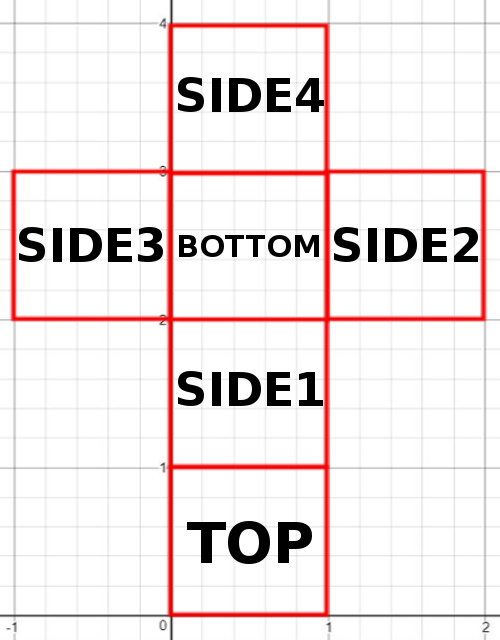Edit: Currently, I am looking for a method which will allow a player to control a 2D mesh and navigate along the surface of a 3D mesh. Visually, this would look like the player is inhabiting a 2D world. This 2D world would be the "wallpaper" (the surface) of a 3D object.
I've been trying to solve this problem by implementing a solution which can do realtime UV mapping of vertices. Note, however, that this may not be the best or even proper solution to this problem and any alternatives which better solve the aforementioned problem are welcome.
My current understanding of UV mapping is that any 3D mesh can be unwrapped so that its vertices, faces, and edges exist in a 2D space at which point a 2D texture can be mapped to these coordinates. If at a certain point in the 2D space, there is no defined face, but the texture is defined for that point, it is simply not applied to the model.
Example:
As you can see, only those parts of the texture defined within the bounds of the faces of the UV map on the right get mapped to the cube on the left.
I, however, am trying to implement a UV map for 2D meshes onto 3D meshes instead of 2D textures onto 3D meshes. I realize that to generalize this problem is too difficult at least for me, so I began with a UV map of a cube as shown above. The code is simple enough for defining a UV map for a cube. Simply define the bounds of each face and supply a function which maps each uv coordinate, based on which face it is located on to a corresponding location in xyz coordinates of the 3D mesh.
Using that rationale I came up with the following (pseudocode):
//define an enum of faces which can be returned from functions
//added NOFACE in case a function can't return any of the faces
enum face = {TOP,
BOTTOM,
SIDE1,
SIDE2,
SIDE3,
SIDE4,
NOFACE};
class UVMapCube
{
private:
//define the bounds for every face in the order of [xMin, xMax, yMin, yMax]
top = [0,1,0,1];
side1 = [0,1,1,2];
side2 = [1,2,2,3];
side3 = [-1,0,2,3];
side4 = [0,1,3,4];
bottom = [0,1,2,3];
scale = 1;
public:
//constructor
UVMapCube(scale)
{
//scale up bounds based on the size of the mesh
for(i = 0; i < 4; i++)
{
top[i] = top[i]*scale;
bottom[i] = bottom[i]*scale;
side1[i] = side1[i]*scale;
side2[i] = side2[i]*scale;
side3[i] = side3[i]*scale;
side4[i] = side4[i]*scale;
}
this.scale = scale;
}
//return which face a given vertex lies in based on its UV coordinates using the bounds of each face
//this is set up so that there is no overlap of faces
face getFace(vertU,vertV)
{
if(vertU >= top[0] && vertU <= top[1] && vertV > top[2] && vertV < top[3])
{
return TOP;
}
else if(vertU >= side1[0] && vertU < side1[1] && vertV >= side1[2] && vertV < side1[3])
{
return SIDE1;
}
else if(vertU >= bottom[0] && vertU < bottom[1] && vertV >= bottom[2] && vertV < bottom[3])
{
return BOTTOM;
}
else if(vertU >= side2[0] && vertU < side2[1] && vertV >= side2[2] && vertV <= side2[3])
{
return SIDE2;
}
else if(vertU > side3[0] && vertU < side3[1] && vertV > side3[2] && vertV < side3[3])
{
return SIDE3;
}
else if(vertU >= side4[0] && vertU < side4[1] && vertV >= side4[2] && vertV <= side4[3])
{
return SIDE4;
}
else
{
return NOFACE;
}
}
//return x,y,z coordinates on a cube based on UV coordinates on the map
Vector3 map(vertU, vertV)
{
face f = getFace(vertU,vertV);
if(f == BOTTOM)
{
return Vector3(vertU, 0, 3*scale-vertV);
}
else if(f == TOP)
{
return Vector3(vertU, 1*scale, vertV);
}
else if(f == SIDE1)
{
return Vector3(vertU, 2*scale-vertV, 1*scale);
}
else if(f == SIDE2)
{
return Vector3(1*scale, vertU-1*scale, 3*scale-vertV);
}
else if(f == SIDE3)
{
return Vector3(0, -vertU, 3*scale-vertV);
}
else if(f == SIDE4)
{
return Vector3(vertU, vertV-3*scale, 0);
}
else
{
return null;
}
}
}
Graphically, it looks something like this:
I got this far. However, the problems begin to arise when considering the "realtime" component of this "realtime UV mapping" approach.
Edit: I am aware that UV maps break the connectivity of the 3D Mesh they represent. However, for my purpose, if I am to implement a realtime UV map, I would need some way to ensure the connectivity of the 3D mesh is represented in the UV map in some artificial way. In other words, what do I do to ensure the user remains on the 3D mesh despite having moved "off" to an undefined location on the corresponding UV map.
For example, where should I map the blue vertex in the example below:
The vertex location cannot be defined unless the vertex had some previous location on one of the defined faces of the map.
For one, if the vertex originates (its previous location before moving off the map) from Side1, it should be mapped somewhere on Side2. If it originates from Side2, it should be mapped somewhere on Side1. And if it originates from the corner of Bottom, Side1, and Side2, it should be mapped somewhere onto the edge shared by Side1 and Side2.
Am I missing something or will I have to simply figure out a bunch of special cases for mapping as I have been doing. Is there perhaps some mathematical approach which encompasses all of these cases completely or something known in the computer graphics community that I don't know?
Otherwise, if there is a better solution to my initial problem other than a "realtime UV mapping" approach, I would be glad to hear it.
Any help would be appreciated.




